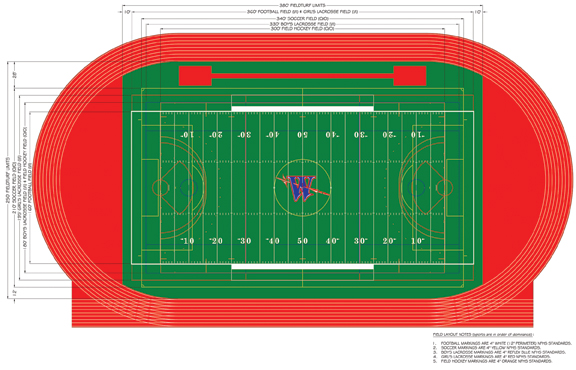Overseeing A Major Facilities Renovation
Waterford High School (Conn.) is in the process of a $60 million new building overhaul with $3.5 million committed to the athletic facilities
Taking part in a complete athletic-facility renovation is a once-in-a-lifetime opportunity for a high school athletic director. When that renovation is fully tax-funded requiring no fundraising, then that simply is the cherry on top.
David Sousa, athletic director at Waterford High School (Conn.) for the last six years, made sure his one crack at a renovation was done right. Despite facing the prospect of having every fall sports team in 2011 forced to play away from home and the inevitable roadblocks that popped up along the way (picture the athletic director digging through piles of artifacts in a cramped storage area, desperately trying to track down a commemorative soccer cup or the Thanksgiving Day football game trophy), Sousa used his clout to influence how the $3.5 million athletic portion (which doesn’t include the new pool) of the $60 million high school overhaul was spent.We (the athletic department) were a big factor in the decision to move this overall project forward. This isnt a stand-alone high school, we have a lot of community activities here, says Sousa. Our town is a nice mix between blue-collar and white-collar (workers), and we have a strong senior citizen base because we have a low tax base. So, they all got on board and saw the big picture of what was needed.
 The Waterford High School (Conn.) field is lined for five sports: football, soccer, boys lacrosse, field hockey and girls lacrosse. The Waterford High School (Conn.) field is lined for five sports: football, soccer, boys lacrosse, field hockey and girls lacrosse. |
Desperate Need For Upgrades
Waterford is a town of 18,897 people (as of June 2009) in New Englands southernmost state. Fueled by three in-town nuclear power plants, the 1970s and 80s treated the residents of Waterford handsomely with low tax rates. The high school, which was originally built in 1956, benefited from the wealth of the 1980s as in 1982 the school added a pool, field house and auditorium.
Since that time, however, the athletic facilities at Waterford have eroded. The baseball team, which has won eight state titles since 1976, plays on a below-average-looking field. Ahead of its time in 1982, the field house in 2011 needed new seating (partially to get up to code with handicap accessibility), a fresh coat of paint and a new sound system. The 1982 pool was elevated, which eventually caused leaking problems in the decades following. And, like at most high schools across the country, the main attractionthe football stadiumsaw too much traffic to withstand the pounding yet didn’t house enough teams to warrant it having its own prime piece of real estate.
We were the typical high school. We had a football field. It started to get overused with the band marching on it, the football team practicing on it, soccer trying to get a game or two on it, field hockey wanting to get on there and we added lacrosse four years ago, so, all of a sudden, it got to the point where our field was a mess, explains Sousa.
Athletic director David Sousa says the bleachers are beautiful blue, which mirrors the school colors. The press box also is new, expanded and updated.
He adds that the school had two soccer-only fields but then with the addition of lacrosse, those fields carried the burden. Before you know it, everything is being overused. We had no irrigation on any of the fields, so it was very difficult to keep them maintained. The parks and recreation department does a great job but, unfortunately, they were overmatched.
Five years ago, as a Band-Aid solution, new sod was laid between the 20-yard lines in an attempt to get a few more years out of it, Sousa adds. He says there is a lot of support for athletics in the town and to be playing on a subpar surface didn’t sit well with the community.
Sousa says the topic of replacing the grass with a FieldTurf surface came up a couple of years prior to his arrival at Waterford but the previous athletic director concentrated too much on a football-only field without paying enough attention to the other sports or looking to upgrade other fields (i.e. baseball).
The first thing I decided was that this is going to be a football, soccer, lacrosse and field hockey field. Were going to get a lot of use out of the field, Sousa says adding that an eight-lane track is being installed around the new football field. Realistically, if you have a child who comes to Waterford and he (or she) plays an outdoor sport, hell be on that field at some point.
The one problem with housing so many teams on the new fieldfiguring out how to line the surface with different dimensions in play for football, soccer, boys lacrosse, field hockey and girls lacrosse, and not making the field look like a giant grid where no one knows where to run.
Originally, we only were going to have lines on the field for football, soccer and boys lacrosse, Sousa says. But, I jumped in and said we need lines for field hockey and girls lacrosse. We couldnt spend the time and effort to hand-paint them on there for every field hockey and girls lacrosse event. We were concerned it might look busy but now that the field is installed, I have no concerns.
The idea of keeping grass in the stadium never was presented as a viable option simply due to the amount of traffic on the field (as evidenced by the need for different sets of lines for five sports). Moving ahead, Sousa says now a typical fall afternoon at Waterfords stadium can feature a junior varsity football game at 3:30, a field hockey game at 5 and finish with a boys soccer game at 7 without any concerns for tearing up the surface.
The field we put in here is the same field at the Coast Guard Academy (located not too far from Waterford) and at Gillette Stadium, where the Patriots play, says Sousa, who adds he toured many facilities and also relied on his previous experiences at other facilities when helping in the product-selection process. We wanted a quality product that we knew would be safe and very good for our athletes.
We did this with a number of productswe asked for them, we preferred them but it still is the decision of the building committee. Because of the economy and there not being a lot of work out there, the bids came in much lower than anticipated, which helped us a lot. Timing is everything. If we did this five years ago, it would have come in much higher.





